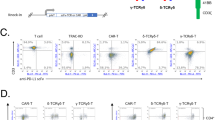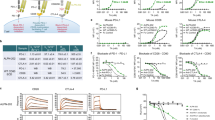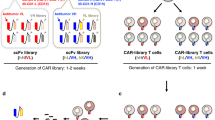Abstract
T cells engineered to express single-chain antibody receptors that incorporate TCR-ζ and cluster designation (CD)28 signaling domains (scFv-α-erbB2-CD28-ζ) can be redirected in vivo to cancer cells that lack triggering costimulatory molecules. To assess the contribution of CD28 signaling to the function of the scFv-CD28-ζ receptor, we expressed a series of mutated scFv-CD28-ζ receptors directed against erbB2. Residues known to be critical for CD28 signaling were mutated from tyrosine to phenylalanine at position 170 or proline to alanine at positions 187 and 190. Primary mouse T cells expressing either of the mutant receptors demonstrated impaired cytokine (IFN-γ and GM-CSF) production and decreased proliferation after antigen ligation in vitro and decreased antitumor efficacy in vivo compared with T cells expressing the wild-type scFv-CD28-ζ receptor, suggesting a key signaling role for the CD28 component of the scFv-CD28-ζ receptor. Importantly, cell surface expression, binding capacity and cytolytic activity mediated by the scFv-CD28-ζ receptor were not diminished by either mutation. Overall, this study has definitively demonstrated a functional role for the CD28 component of the scFv-CD28-ζ receptor and has shown that incorporation of costimulatory activity in chimeric scFv receptors is a powerful approach for improving adoptive cancer immunotherapy.
This is a preview of subscription content, access via your institution
Access options
Subscribe to this journal
Receive 12 print issues and online access
$259.00 per year
only $21.58 per issue
Buy this article
- Purchase on Springer Link
- Instant access to full article PDF
Prices may be subject to local taxes which are calculated during checkout






Similar content being viewed by others
Abbreviations
- Bcl-XL:
-
B cell lymphoma/leukemia-x gene
- CD:
-
cluster designation
- LAK:
-
lymphokine activated killer
- PI3 kinase:
-
phosphatidylinositol 3-kinase
- scFv:
-
single chain variable domain
- TAA:
-
tumor associated antigen
- TIL:
-
tumor-infiltrating lymphocyte
- VH:
-
variable heavy chain
- VL:
-
variable light chain
References
Rosenberg SA, Lotze MT, Yang JC, et al. Prospective randomized trial of high-dose interleukin-2 alone or in conjunction with lymphokine-activated killer cells for the treatment of patients with advanced cancer. J Natl Cancer Inst. 1993;85:622.
Rosenberg SA, Yannelli JR, Yang JC, et al. Treatment of patients with metastatic melanoma with autologous tumor-infiltrating lymphocytes and interleukin 2. J Natl Cancer Inst. 1994;86:1159.
Dudley ME, Wunderlich JR, Robbins PF, et al. Cancer regression and autoimmunity in patients after clonal repopulation with antitumor lymphocytes. Science. 2002;298:850.
Yee C, Thompson JA, Roche P, et al. Melanocyte destruction after antigen-specific immunotherapy of melanoma: direct evidence of t cell-mediated vitiligo. J Exp Med. 2000;192:1637.
Dudley ME, Wunderlich JR, Yang JC, et al. A phase I study of nonmyeloablative chemotherapy and adoptive transfer of autologous tumor antigen-specific T lymphocytes in patients with metastatic melanoma. J Immunother. 2002;25:243.
Yee C, Thompson JA, Byrd D, et al. Adoptive T cell therapy using antigen-specific CD8+ T cell clones for the treatment of patients with metastatic melanoma: in vivo persistence, migration, and antitumor effect of transferred T cells. Proc Natl Acad Sci USA. 2002;99:16168.
Lotze MT, Matory YL, Rayner AA, et al. Clinical effects and toxicity of interleukin-2 in patients with cancer. Cancer. 1986;58:2764.
Belldegrun A, Webb DE, Austin III HA, et al. Effects of interleukin-2 on renal function in patients receiving immunotherapy for advanced cancer. Ann Intern Med. 1987;106:817.
Ettinghausen SE, Moore JG, White DE, Platanias L, Young NS, Rosenberg SA . Hematologic effects of immunotherapy with lymphokine-activated killer cells and recombinant interleukin-2 in cancer patients. Blood. 1987;69:1654.
Garrido F, Cabrera T, Concha A, Glew S, Ruiz-Cabello F, Stern PL . Natural history of HLA expression during tumour development. Immunol Today. 1993;14:491.
Hellstrom KE, Hellstrom I, Chen L . Can co-stimulated tumor immunity be therapeutically efficacious? Immunol Rev. 1995;145:123.
Moritz D, Wels W, Mattern J, Groner B . Cytotoxic T lymphocytes with a grafted recognition specificity for ERBB2-expressing tumor cells. Proc Natl Acad Sci USA. 1994;91:4318.
Hwu P, Yang JC, Cowherd R, et al. In vivo antitumor activity of T cells redirected with chimeric antibody/T-cell receptor genes. Cancer Res. 1995;55:3369.
Darcy PK, Kershaw MH, Trapani JA, Smyth MJ . Expression in cytotoxic T lymphocytes of a single-chain anti-carcinoembryonic antigen antibody. Redirected Fas ligand-mediated lysis of colon carcinoma. Eur J Immunol. 1998;28:1663.
Darcy PK, Haynes NM, Snook MB, et al. Redirected perforin-dependent lysis of colon carcinoma by ex vivo genetically engineered CTL. J Immunol. 2000;164:3705.
Haynes NM, Snook MB, Trapani JA, et al. Redirecting mouse CTL against colon carcinoma: superior signaling efficacy of single-chain variable domain chimeras containing TCR-zeta vs Fc epsilon RI-gamma. J Immunol. 2001;166:182.
Eshhar Z, Waks T, Bendavid A, Schindler DG . Functional expression of chimeric receptor genes in human T cells. J Immunol Methods. 2001;248:67.
Eshhar Z, Waks T, Gross G, Schindler DG . Specific activation and targeting of cytotoxic lymphocytes through chimeric single chains consisting of antibody-binding domains and the gamma or zeta subunits of the immunoglobulin and T-cell receptors. Proc Natl Acad Sci USA. 1993;90:720.
Roberts MR, Cooke KS, Tran AC, et al. Antigen-specific cytolysis by neutrophils and NK cells expressing chimeric immune receptors bearing zeta or gamma signaling domains. J Immunol. 1998;161:375.
Haynes NM, Smyth MJ, Kershaw MH, Trapani JA, Darcy PK . Fas-ligand-mediated lysis of erbB-2-expressing tumour cells by redirected cytotoxic T lymphocytes. Cancer Immunol Immunother. 1999;47:278.
Romeo C, Amiot M, Seed B . Sequence requirements for induction of cytolysis by the T cell antigen/Fc receptor zeta chain. Cell. 1992;68:889.
Haynes NM, Trapani JA, Teng MW, et al. Rejection of syngeneic colon carcinoma by CTLs expressing single-chain antibody receptors codelivering CD28 costimulation. J Immunol. 2002;169:5780.
Haynes NM, Trapani JA, Teng MW, et al. Single-chain antigen recognition receptors that costimulate potent rejection of established experimental tumors. Blood. 2002;100:3155.
Hombach A, Wieczarkowiecz A, Marquardt T, et al. Tumor-specific T cell activation by recombinant immunoreceptors: CD3 zeta signaling and CD28 costimulation are simultaneously required for efficient IL-2 secretion and can be integrated into one combined CD28/CD3 zeta signaling receptor molecule. J Immunol. 2001;167:6123.
Maher J, Brentjens RJ, Gunset G, Riviere I, Sadelain M . Human T-lymphocyte cytotoxicity and proliferation directed by a single chimeric TCRzeta/CD28 receptor. Nat Biotechnol. 2002;20:70.
Pages F, Ragueneau M, Rottapel R, et al. Binding of phosphatidylinositol-3-OH kinase to CD28 is required for T-cell signalling. Nature. 1994;369:327.
Stein PH, Fraser JD, Weiss A . The cytoplasmic domain of CD28 is both necessary and sufficient for costimulation of interleukin-2 secretion and association with phosphatidylinositol 3′-kinase. Mol Cell Biol. 1994;14:3392.
Holdorf AD, Green JM, Levin SD, et al. Proline residues in CD28 and the Src homology (SH)3 domain of Lck are required for T cell costimulation. J Exp Med. 1999;190:375.
Harada Y, Tokushima M, Matsumoto Y, et al. Critical requirement for the membrane-proximal cytosolic tyrosine residue for CD28-mediated costimulation in vivo. J Immunol. 2001;166:3797.
Okkenhaug K, Wu L, Garza KM, et al. A point mutation in CD28 distinguishes proliferative signals from survival signals. Nat Immunol. 2001;2:325.
Prasad KV, Cai YC, Raab M, et al. T-cell antigen CD28 interacts with the lipid kinase phosphatidylinositol 3-kinase by a cytoplasmic Tyr(P)-Met-Xaa-Met motif. Proc Natl Acad Sci USA. 1994;91:2834.
Cai YC, Cefai D, Schneider H, Raab M, Nabavi N, Rudd CE . Selective CD28pYMNM mutations implicate phosphatidylinositol 3-kinase in CD86-CD28-mediated costimulation. Immunity. 1995;3:417.
Truitt KE, Shi J, Gibson S, Segal LG, Mills GB, Imboden JB . CD28 delivers costimulatory signals independently of its association with phosphatidylinositol 3-kinase. J Immunol. 1995;155:4702.
Serbina NV, Lazarevic V, Flynn JL . CD4(+) T cells are required for the development of cytotoxic CD8(+) T cells during Mycobacterium tuberculosis infection. J Immunol. 2001;167:6991.
Acknowledgements
We thank Rachel Cameron and the staff of the Peter MacCallum Cancer Institute animal facilities for the caring and maintenance of mice used in this study. We also thank Dr Sarah Russell for intellectual input concerning biochemical experiments.
Author information
Authors and Affiliations
Corresponding author
Additional information
MJS and JAT are currently supported by National Health and Medical Research Council of Australia (NH&MRC) Principal Research Fellowships. This study was supported by a Program Grant from the Susan G Komen Breast Cancer Foundation and a project grant from The Cancer Council Victoria.
Rights and permissions
About this article
Cite this article
Moeller, M., Haynes, N., Trapani, J. et al. A functional role for CD28 costimulation in tumor recognition by single-chain receptor-modified T cells. Cancer Gene Ther 11, 371–379 (2004). https://doi.org/10.1038/sj.cgt.7700710
Received:
Published:
Issue Date:
DOI: https://doi.org/10.1038/sj.cgt.7700710
Keywords
This article is cited by
-
CRISPR Takes the Front Seat in CART-Cell Development
BioDrugs (2021)
-
Rewiring T-cell responses to soluble factors with chimeric antigen receptors
Nature Chemical Biology (2018)
-
Strategies to genetically engineer T cells for cancer immunotherapy
Cancer Immunology, Immunotherapy (2016)
-
Chimeric antigen receptor–engineered T cells as oncolytic virus carriers
Molecular Therapy - Oncolytics (2015)
-
Clinical application of genetically modified T cells in cancer therapy
Clinical & Translational Immunology (2014)



